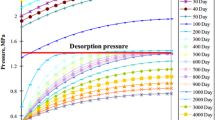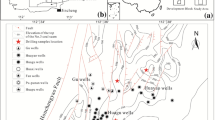Abstract
The stress state of coal surrounding a coalbed methane (CBM) production well is affected by the bottom hole flowing pressure (BHFP). The permeability of coal shows a marked change under compression. The BHFP must be restricted to a specific range to favor higher permeability in the surrounding coal and thus higher productivity of the well. A new method to determine this specific range is proposed in this paper. Coal has a rather low tensile strength, which induces tensile failure and rock disintegration. The deformation of coal samples under compression has four main stages: compaction, elastic deformation, strain hardening, and strain softening. Permeability is optimal when the coal samples are in the strain softening stage. The three critical values of BHFP, namely, p wmin, p wmid, and p wupper, which correspond to the occurrence of tensile failure, the start of strain softening, and the beginning of plastic deformation, respectively, are derived from theoretical principles. The permeability of coal is in an optimal state when the BHFP is between p wmin and p wmid. The BHFP should be confined to this specific range for the efficient drainage of CBM wells. This method was applied to field operations in three wells in the Hancheng CBM field in China. A comprehensive analysis of drainage data and of the BHFP indicates that the new method is effective and offers significant improvement to current practices.






Similar content being viewed by others
References
Durucan S, Edwards JS (1986) The effects of stress and fracturing on permeability of coal. Min Sci Tech 3:205–216
Fjaer E, Holt RM, Horsrud P, Raaen AM, Risnes R (2008) Petroleum related rock mechanics, 2nd edn. Elsevier, Amsterdam
Ge JL (2003) The modern mechanics of fluids flow in oil reservoir. Petroleum Industry Press, Beijing (in Chinese)
Li XC, Kang YL, Luo PY (2009) Rock deformation mechanisms and its influence on percolation ability for CBM reservoirs. China Min Mag 18(3):99–102 (in Chinese)
Li S, Tang DZ, Xu H, Yang Z (2012) Advanced characterization of physical properties of coals with different coal structures by nuclear magnetic resonance and X-ray computed tomography. Comput Geosci 48:220–227
Ma Q, Harpalani S, Liu SM (2011) A simplified permeability model for coalbed methane reservoirs based on matchstick strain and constant volume theory. Int J Coal Geol 85:43–48
McKee CR, Bumb AC, Koenig RA (1988) Stress-dependent permeability and porosity of coal and other geologic formations. SPE Form Eval 3(1):81–91. doi:10.2118/12858-PA
Ngwenya BT, Kwon O, Elphick SC, Main IG (2003) Permeability evolution during progressive development of deformation bands in porous sandstones. J Geophys Res 108(B7):2343. doi:10.1029/2002JB001854
Shedid SA (2009) Experimental investigations of stress-dependent petrophysical properties of coalbed methane (CBM). In: SPE middle east oil and gas show and conference, Manama, Bahrain, 15–18 March 2009. doi:10.2118/119998-MS
Somerton WH, Söylemezoğlu IM, Dudley RC (1975) Effect of stress on permeability of coal. Int J Rock Mech Min Sci Geomech Abstr 12:129–145
Su XB, Chen JF, Sun JM, Cheng ZB et al (2001) Geology, exploration and development of coalbed methane. Science Press, Beijing (in Chinese)
Wang J-A, Park HD (2002) Fluid permeability of sedimentary rocks in a complete stress–strain process. Eng Geol 63:291–300
Wang HL, Xu WY (2013) Relationship between permeability and strain of sandstone during the process of deformation and failure. Geotech Geol Eng 31:347–353. doi:10.1007/s10706-012-9588-0
Wang GX, Wang ZT, Rudolph V, Massarotto P, Finley RJ (2007) An analytical model of the mechanical properties of bulk coal under confined stress. Fuel 86:1873–1884
Xu ZL (1990) Elastic mechanics. Higher Education Press, Beijing (in Chinese)
Zhang YX, He YN (2008) Rock mechanics. China Architecture and Building Press, Beijing (in Chinese)
Zhang XY, Yan SW (2004) Fundamental of geotechnics plasticity. Tian Jin University Press, Tian Jin (in Chinese)
Zhang J, Standifird WB, Roegiers JC, Zhang Y (2007) Stress-dependent fluid flow and permeability in fractured media: from lab experiments to engineering applications. Rock Mech Rock Eng 40(1):3–21. doi:10.1007/s00603-006-0103-x
Zheng YR, Shen ZJ, Gong XN (2002) The principles of geotechnical plastic mechanics. China Architecture and Building Press, Beijing (in Chinese)
Zhong FX (2001) Gas reservoir engineering. Petroleum Industry Press, Beijing (in Chinese)
Acknowledgments
This work was funded by the National Science and Technology Major Project (China) under contract 2011ZX05038-004.
Author information
Authors and Affiliations
Corresponding author
Rights and permissions
About this article
Cite this article
Zhao, B., Wang, ZY., Hu, AM. et al. Controlling Bottom Hole Flowing Pressure Within a Specific Range for Efficient Coalbed Methane Drainage. Rock Mech Rock Eng 46, 1367–1375 (2013). https://doi.org/10.1007/s00603-013-0476-6
Received:
Accepted:
Published:
Issue Date:
DOI: https://doi.org/10.1007/s00603-013-0476-6




